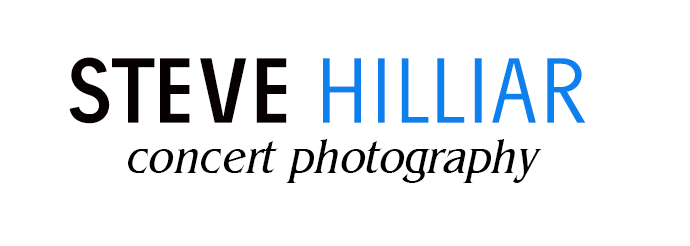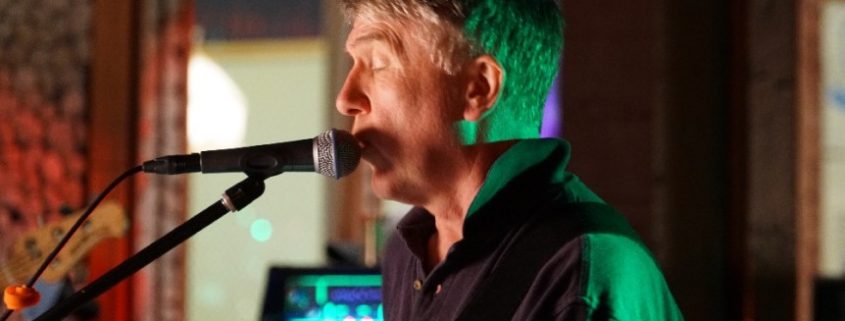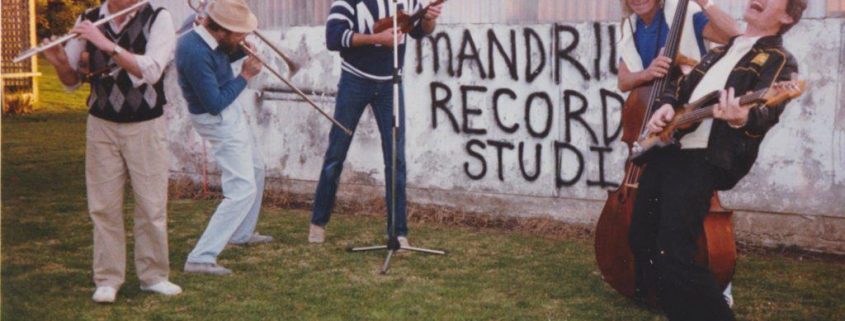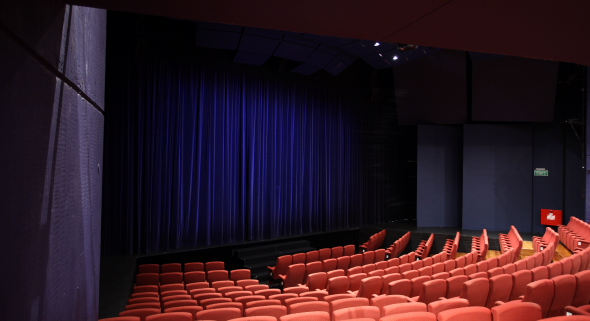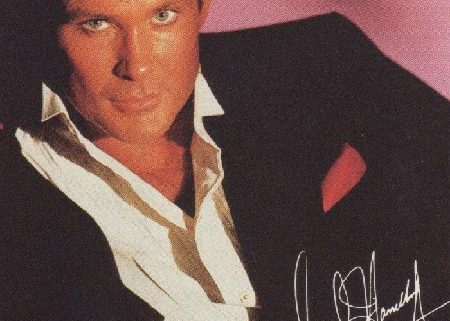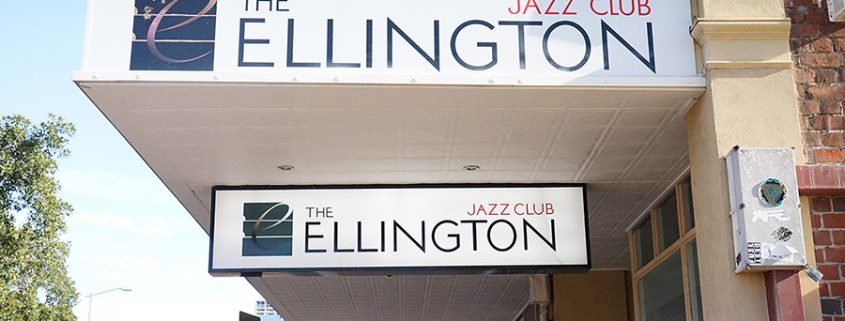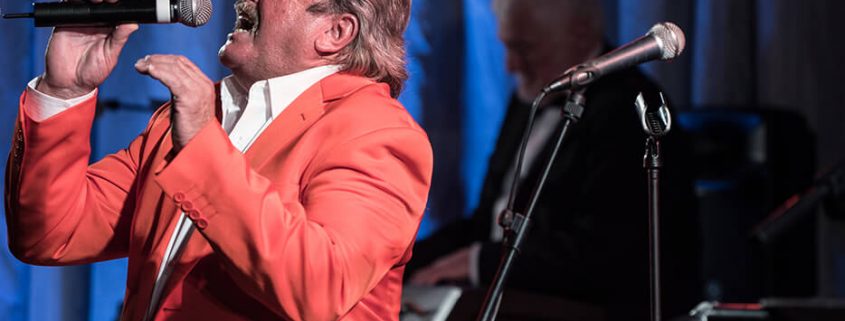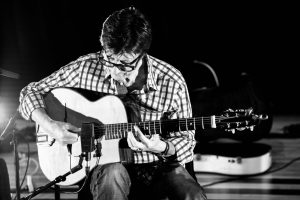The Human Kindness Band reside in Nelson New Zealand.
One sensational group comprising of:
Bruce McGregor, Drums; Glynn Olsen, Lead Guitar; Steve Mitchell, Vocals, Slide Guitar, Guitar; Danny Sugar, Bass.
Article by Glyn Tucker on his recording of David Hasselhoff
In 1986, long before the term “Hoff” had been coined, I was asked to record an album with a popular TV star, with a view to doing an extensive TV advertising promotion in the USA.
The partners who were funding the project had contacts in the USA who would facilitate the promotion and sale of the finished LP’s and cassettes. (CD’s were not yet fully established as the major format for music sales) A similar project had been successful in the USA with actor David Soul, famous from the Starsky and Hutch TV series, and so the partners went off searching for suitable actor/singer of similar talents. David Hasselhoff was a superstar at the time through his portrayal of Michael Knight in the hit TV series, Knight Rider. Michael Knight and his talking Kit car was a hit in 64 countries, including New Zealand, but by 1986 that series had come to an end. (much to the disappointment of millions of fans around the world) He seemed to have all the credentials, so long as he could sing. A deal was worked out with his management and my record label, Reaction Records was contracted to produce a record. I became Executive producer.
I got in touch with David and talked through possible music genres and requested a cassette of some of his previous vocal work, which included a performance with Marie Osmond at Disneyland, and a previous LP he had made called, “ Knight Rocker”. From these listening s I made a decision that we should make an album of love songs and ballads rather than rock. David had a huge female fan-base from his earlier performances on the TV soap, “The Young and the Restless”, and I was planning to exploit that market. I considered his voice more suited to this style. From there we began trawling through various songs that might suit, culminating in a long list of possibles.
I chose Bruce Lynch as the front line producer, and he in turn suggested getting Dave McRae to work with him on arrangements and do the keyboard parts. David duly arrived in Auckland a few weeks later along with his minder, Buddy, and they were accommodated in a nice house in Epsom. (thanks to Gray and Trish Bartlett) We all got together at Bruce Lynch’s home studio where a few days of “auditioning” songs, keys, arrangements took place. Once the track list was reduced to a short list, Bruce and Dave wrote the arrangement charts and prepared for recording. I booked the studio for the following week, and David took some vocal coaching lessons with local teacher Robyn Hill, to get his voice into shape. Although David was not a seasoned singer, his approach to his craft was always very professional.
As fate would have it, Gray Bartlett was touring New Zealand with the “Kit car” from the Knight Rider TV series at the same time as we were making the record. They were doing shopping malls and such, so that kids (and other fans) could sit in the car and have it talk to them. (nice trick, that) Gray arranged for Kit to visit the Starship Children’s Hospital in Auckland, with David as well! He was so good with the kids, signing autographs and taking time to visit the sick children in the wards who were unable to make it down to the car park to see Kit. David was sporting an All Black jersey for the occasion; and in fact became a big fan of the AB’s.
David wanted to include two songs in Spanish, because the TV show had been so huge in South American countries. We hired a Spanish lecturer from Auckland University to sit in on the vocal sessions to check his pronunciation; it turned out to be a good move since some of his Spanish was a bit dodgy. Finally we completed the album four weeks from his time of arrival in Auckland, and masters were duly delivered to the American record company for them to ply their marketing expertise. The album was titled, “Lovin’ Feelings”.
Everybody liked David. I found him to be talented, with a great sense of humor, keen to get involved with Kiwi culture, and a pleasure to have around. He relied on Buddy to arrange his diary, book travel, and make sure he was on time for appointments. They were good “buddies”, working as a team.
The outcome of the USA promotion was disappointing to say the least. Before spending megabucks on a national campaign, it was usual to do a small test campaign on local TV to gauge the reaction. The chosen city for this test was Nashville, Tennessee, and the reaction was poor. This resulted in dumping the project in the USA. (which had been the whole focus of the recording)
I never understood why a sophisticated album of MORE love songs with two Spanish songs should be tested in Nashville, the home of country music. Regardless, we were left with a lemon, and the partners were not happy.
Although we had always targeted the USA as being our prime market, I took on the responsibility of pitching it to “the rest of the world”. I had been attending the MIDEM music festival in Cannes, France for several years (promoting NZ music) and saw this marketplace as the best opportunity to get interest from international record companies. January 1987 saw David Hasselhoff in Cannes with me, helping with the international pitch. It was an exciting week for me.
Business aside, trotting around Cannes with the Knight Rider (everybody knew David as his TV persona, Michael Knight) was akin to having Jesus as a buddy. No longer did I need to get in line at a restaurant. With Michael Knight at my side we would be ushered to the front of the line and got the best table. It was truly amazing how popular this man was in Europe. I managed to complete licensing deals with CBS Austria, and one with a Finland company, each with reasonable advances payable; and had several other interested countries that turned out to be not forthcoming with the up front money. So the Cannes trip gave us some hope of saving the project, at least in part.
On the way home I was invited to stay a few days at David’s home near Studio City LA. I met his lovely wife Catherine (since divorced), but she was mostly busy with very early-morning starts on the set of the “soap” series in which she starred. Their place had every luxury (as expected) and he was very hospitable; giving me his own Pontiac Trans Am (same as Kit) to get around LA. I took his housekeeper to Universal Studios in the Pontiac one day where they had the original Kit car on display, talking to the fans as we’d seen in Auckland. David also took me to a big-time boxing match; ringside seats at The Forum, where the place was jammed with celebrities who all knew David.
He introduced me to Sly and Frank Stallone, Floyd Patterson (ex Heavyweight World Champ), and I found myself sitting next to Michael Landon (Bonanza). It was a great night, although the local favorite, known as “Rocky” (very original) took a serious beating. David and I visited him in his dressing room after the fight. I overheard Sly Stallone telling the beaten fighter, “ You done good kid, just like Rocky!”
Over the ensuing weeks and months we continued to keep in touch whilst working on whatever promotions were currently happening in various places around the world. It was during these events that David made contact with a successful record producer in Germany. David consequently did some recordings in Germany culminating in a massive hit single in 1989, “Is Everybody Happy”. I must confess to being surprised that such a load of rubbish had made it to #1 on the German pop charts; but I was happy that David had a cracked it. Through this success, DH became an even bigger star in Germany than Michael Knight had been. And due to his popularity we managed to get few sales of our Lovin’ Feelings LP, imported from CBS, Austria.
In retrospect this was not a financially successful project for the partners, but it was a great experience for me, and my team who worked with David. And I can be proud that we made a pretty good record of it’s genre that still sounds good today.
Cheers to The Hoff.
It is with deep sadness I have to announce this very bad news. It appears as our wonderful Maidment Theatre in Auckland has been closed.
This is nothing short of a disaster and all I can say it I am so glad we were able to have the Hank Marvin Gypsy Jazz group play there on November 20th 2015. It appears the theatre is an earthquake risk and at this stage we are not certain if it will reopen. There is no doubt this was one of the very best artistic theaters in this country and we are devastated about this news.
Below is a letter send out by Lester MaCrath general Manager.
I had never come across Dave Alley until Tuesday 9th June 2015. That is seriously to my detriment.
Dave is one sensational guitarists and yes he has done more than his ten thousand hours. Dave was performing at “Corellis” a very good restaurant in Devonport New Zealand.
Dave was appearing with Cat Tunks and they claim the music is New Zealand blues noir and soul.
Unfortunately i had not taken my camera gear and had to suffice with my trusty iPhone 6 plus.
Corellis has a musical event every second Tuesday and they have no problem filling the place on a winters evening during the week. Not only is the food bargain prices but the quality is also terrific.
How they find these superb musicians is well beyond me and I am astounded at the talent we are able to witness for ridiculously low prices.
Dave Alley blew me away, he hardly looked at his fretboard, yet sung and backed Cat Tunks with fluid licks that even would make Tommy Emanuel sit up and take notice.
My goal now is to seek Dave Alley out at his next gig and make certain I take my Sony A7s to capture some good still shots together with an example of his ability on video.
Anyone in New Zealand who are reading this and can get down to Devonport to “Corellis” and witness great musical performances along with value for money in the culinary department will not regret it. Dave Alley is a performer to watch out for, if you see he is performing at a place near you get out and support this extraordinary talent.
Hank Marvin and his Gypsy Jazz Quartet from Perth Western Australia, made a surprise visit to the Christchurch Jazz Festival in April 2015.
They performed at the Charles Luney Auditorium, St Margaret’s College, 12 Winchester Street.
The group consisted of Hank Marvin (ex Shadows) on guitar, Gary Taylor (ex Herd) on Guitar, Nunzio Mondia on Accordion and Robbie Pisano on double bass.
They also made a visit nationwide in 2013 and their last visit was in November of 2015.
The cities visited in the last tour was Nelson, Wellington, Tauranga. and Auckland. Prior to the last visit they performed at the Fly By Night Club in Perth their home town.
Mandrill Recording Studios and David Hasselhoff
I just came across photo from the 80’s with The Hoff.
This was a spoof shot taken in 1986, soon after The Hoff arrived in Auckland to record the album, “Lovin’ Feelings”.
Bruce Lynch was the producer and David H was taken to Bruce’s home for pre-production session with a handful of musicians.
David knew from earlier communications that we would be making the record at Mandrill Recording Studios, but Bruce and his muso friends set him up to believe that The Boatshed at the back of Bruce’s home was it! (A few years later “The Boatshed” became Bruce’s seriously good recording studio, but at that time was… just a boat shed.)
L to R, Bruce Lynch, Dave McRae, David Hasselhoff, Frank Gibson Jnr, and Glyn Tucker Jnr.
(see the story of the making of “Lovin’ Feelings” on our Blog of March 2015)
Glyn Tucker
Another lucky break for me, the opportunity to attend the rehearsals and concerts in April 2015 for Hank Marvin Gypsy Jazz Ensemble. The chance to take photos and video as well as enjoy the company with a bunch of great people.
I will post photos in the gallery.
Save
Save
Save
Save
Save
Many people seem to think there is very little skill in Concert photography. However it is one of the most challenging fields you can endure with a camera, with concert photography you have almost no control with your planned shots. In other words we cannot control the performers being photographed, there is no way we have control over the lighting, as lighting is constantly changing and then above everything else we cannot control the angles.
The main point that I have also reiterated on before, we cannot forget that the audience have paid good money to see their favourite artist, we cannot get in their line of view and spoil their show. Sometimes there are limitations placed on photographers by the promoter, there can also be limitations placed on photographers by the venue itself. All of these things must be taken into account when preparing a concert shoot.
I hear you, you want the answer to how it can be done as you are ready to start right? Well the first thing to think about is how you can lower the aspects that I have mentioned above.
A good place to start is at the smaller shows, something relatively easy to access, somewhere you can easily move around without interrupting anyone. It could be a thought to start with maybe a promoter you know personally or a band or artist you know. I was lucky way back when I was invited to a Cliff Richard show at Wembley and was able to get behind stage as well as the green room where I could get some shots without worrying and this was in the days of film, way before the digital camera era. My camera then was a Nikon FE and I still own it today.
Equipment
It’s not the camera that is important but the person behind it.
There is no doubt skill is the answer to any type of photography but with concert photography the camera equipment being used is vital. Many of the problems are associated with shooting in low light, ideally we need a camera capable of shooting at a higher ISO rating without noise and ideally a lens capable of opening up to at least 2.8. My preferred unit for this is my trust Sony A7s with a Sony 70-200.
Another consideration is shooting rock bands, normally a higher shutter speed is required due to the fast and dynamic actions of the performers, singers who are all over the place, jumping in the air, the drummer with his sticks in the air etc.
Luckily my Sony A7s is capable of extremely high ISO, making it perfect for low light conditions, it is very usable to 12500 ISO but can go to the crazy value of 105,000.
High ISO and Noise
In my opinion a slightly noisy picture can still look great and there are tools such as Adobe Lightroom available to reduce the noise at a later stage. That is one amazing benefit of digital photography. If you use a low ISO rating to avoid the noise you are far more likely to end up with a blurry photo that is unusable. Another point worth consideration is to use black and white as noise is not as pronounced.
Correct exposure
How do we know how to measure light? This the first difficulty we are faced with in any photography let alone concert photography. The measurement of the light that allows us to select the correct exposure. In live concerts we’ll usually measure light from a point which we want to expose by using the point metering in our camera. However with modern cameras like the Sony A7s there are other options available as well.
In many live performances there can be a variety of sets of different and repeating light, so you should keep in mind the appropriate parameters for the different light and then for example as soon as spot will be on the singer we will know what the appropriate parameters for our frame.
You can check your histogram and in addition check in the monitor for overexposed points, to ensure that the important objects in the frame are exposed properly. One of the most frustrating things is to get back home with a picture that looks good on the camera and then we find out in our computer screen that it’s overexposed or underexposed. Never the less always make certain you shoot in RAW as the flexibility this gives you in post production means most under or over exposures can be overcome once again with the likes of Adobe Lightroom.
Flash or no flash?
You are in a big concert, a long way from the stage, all around you are hundreds of flashes from cameras from people who are trying to take pictures of the show. Well sadly your flash will have zero effect on the group or a singer. In many situations like this the stage will turn out dark.
So when you are far from the stage – turn off the flash. In my opinion you should never use flash at a concert, it is inconsiderate and with a camera like the Sony A7s there is no need for it.
I can write about all aspects of using flash, yes it has its place but please not in a concert.
Waiting for the right moment
If it is too dark and we are distance from the stage, the idea is to wait until a spot light or other lights are turned on, the narrow, focused and strong light, will light the artist. You must remember: photographing a concert is not like most other types of photography where it is important to see everything. We are looking for atmosphere, usually extremely difficult to come by.
Camera constraints
Old cameras, compact cameras, together with lenses above F4 Aperture can cause problems when trying to capture a subject with the correct lighting. You can easily land up with a silhouette due to lighting behind the subject similar shooting into sunlight. This is because lights are always changing and that is why I believe it is most important to choose the right gear. The Sony A7s is a spectacular low light unit and very hard to beat. It is remarkable what that camera can do in such tricky situations.
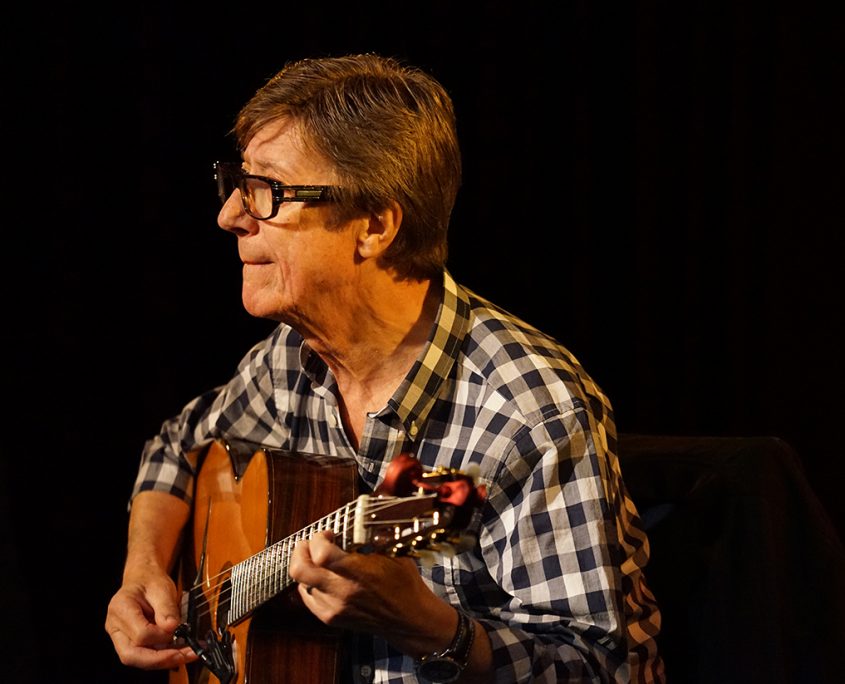
Hank Marvin
I was introduced to Hank Marvin (The Shadows) back in 2013 by my friend of 48 years Gray Bartlett. What happened since that meeting is nothing short of amazing and I intend writing the full story in detail. This will start from back in the early 1960’s because the events leading up to the current situation have a bearing on it and quite remarkable. I hope to produce a book about it both in digital format and as a hard copy with high quality pictures. Parts of the events can be read in my life story on this site but not in real detail. Since that time I have become extremely passionate about the art of Concert Photography which happens to be very challenging to say the least.
2013 was the very first tour of New Zealand by the Hank Marvin Gypsy Jazz Ensemble. Before the tour took place Neil Collins from Radio Dunedin had the opportunity to interview Hank on the telephone before the tour.
.
- Click on the audio file above to listen.
- Hear Hank with his typical dry sense of humour.
- Once again a piece of history we are privileged to listen to;
- The tour was presented and organized by Gray Bartlett
If it was not for Gray Bartlett and his generosity I would have never met hank Marvin and I would have not had the opportinty to take great photos and video of the concerts. The day Gray phoned me at the beginning of 2013 and informed me of his intention to promote the tour just floored me. What has gone on since has been a dream come true.
- I met Hank Marvin for the first time in 2013.
- My involvement during that tour was another dream that came true.
- 2015 was a fantastic year as I got personally involved with touring both Australia and New Zealand with hank and the boys;
- It continues to happen. We make our own luck do we not?
Categories
 Melissa EtheridgeOctober 21, 2018 - 10:51 pm
Melissa EtheridgeOctober 21, 2018 - 10:51 pm Variety Artists Club 2018October 18, 2018 - 3:54 am
Variety Artists Club 2018October 18, 2018 - 3:54 am The DynosaursMarch 8, 2018 - 3:30 am
The DynosaursMarch 8, 2018 - 3:30 am Mental as AnythingMarch 8, 2018 - 1:07 am
Mental as AnythingMarch 8, 2018 - 1:07 am MoroccoFebruary 26, 2018 - 8:06 am
MoroccoFebruary 26, 2018 - 8:06 am Midge MarsdenFebruary 25, 2018 - 10:15 pm
Midge MarsdenFebruary 25, 2018 - 10:15 pm
